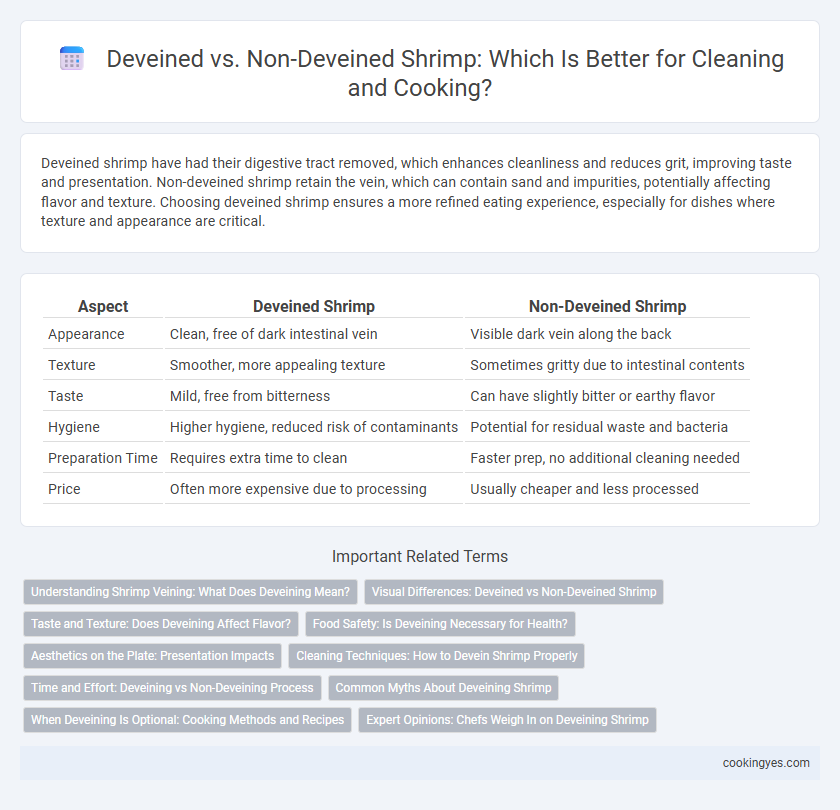Deveined shrimp have had their digestive tract removed, which enhances cleanliness and reduces grit, improving taste and presentation. Non-deveined shrimp retain the vein, which can contain sand and impurities, potentially affecting flavor and texture. Choosing deveined shrimp ensures a more refined eating experience, especially for dishes where texture and appearance are critical.
Table of Comparison
| Aspect | Deveined Shrimp | Non-Deveined Shrimp |
|---|---|---|
| Appearance | Clean, free of dark intestinal vein | Visible dark vein along the back |
| Texture | Smoother, more appealing texture | Sometimes gritty due to intestinal contents |
| Taste | Mild, free from bitterness | Can have slightly bitter or earthy flavor |
| Hygiene | Higher hygiene, reduced risk of contaminants | Potential for residual waste and bacteria |
| Preparation Time | Requires extra time to clean | Faster prep, no additional cleaning needed |
| Price | Often more expensive due to processing | Usually cheaper and less processed |
Understanding Shrimp Veining: What Does Deveining Mean?
Deveining shrimp refers to the removal of the dark digestive tract that runs along the shrimp's back, which can contain grit and may affect flavor. Understanding shrimp veining is crucial for proper cleaning, as deveining enhances the shrimp's texture and reduces potential bitterness. While non-deveined shrimp are edible, many prefer deveined shrimp for a cleaner taste and improved presentation.
Visual Differences: Deveined vs Non-Deveined Shrimp
Deveined shrimp feature a clean, translucent back where the dark digestive tract, or vein, has been removed, resulting in a smoother and more visually appealing appearance. Non-deveined shrimp display a darker, visible vein running along the curvature of their backs, which can appear unappetizing to some consumers. The removal of the vein enhances not only the aesthetic presentation but also the perceived freshness and quality of the shrimp.
Taste and Texture: Does Deveining Affect Flavor?
Deveining shrimp removes the digestive tract, which can sometimes carry grit or a slightly bitter taste, resulting in a cleaner, more delicate flavor and a smoother texture. Non-deveined shrimp may have a subtly earthier taste, but the vein itself does not significantly impact overall flavor for most palates. Texture differences are minimal, with deveined shrimp often perceived as more visually appealing and tender during cooking.
Food Safety: Is Deveining Necessary for Health?
Deveining shrimp involves removing the dark intestinal tract, which may contain sand, bacteria, and impurities affecting food safety and taste. While not strictly necessary for health, deveining reduces potential contaminants and improves the overall cleanliness of shrimp, minimizing the risk of foodborne illnesses. Proper cooking and handling remain essential, but deveining offers an extra layer of precaution for safer consumption.
Aesthetics on the Plate: Presentation Impacts
Deveined shrimp offer a cleaner and more polished appearance, enhancing the overall plate presentation and making dishes visually appealing. The removal of the dark vein improves texture uniformity, avoiding any distractions caused by the digestive tract's discoloration. Non-deveined shrimp may appear less refined, potentially affecting diners' perception of freshness and quality despite identical taste profiles.
Cleaning Techniques: How to Devein Shrimp Properly
Deveining shrimp involves removing the dark digestive tract along the back, which can affect both taste and texture. To properly devein shrimp, first remove the shell and legs, then make a shallow cut along the back to expose the vein, using a toothpick or deveining tool to lift it out gently. Thorough cleaning not only enhances flavor but also ensures the shrimp is free from grit and impurities, making it safer and more enjoyable to eat.
Time and Effort: Deveining vs Non-Deveining Process
Deveining shrimp involves removing the dark digestive tract, which requires extra time and careful precision compared to non-deveining, where shrimp are cleaned more quickly but may retain the vein. The deveining process typically adds 2 to 4 minutes per shrimp, increasing overall preparation time and effort in large batches. Non-deveined shrimp save time in cleaning but may compromise presentation and texture for some culinary applications.
Common Myths About Deveining Shrimp
Many believe deveining shrimp is solely for aesthetic purposes, but the "vein" is actually the digestive tract which can contain grit or waste affecting taste. Some assume non-deveined shrimp are unsafe to eat, yet cooking usually neutralizes any bacteria present in the vein. Eating shrimp with the vein intact is a common practice in various cuisines, dispelling the myth that deveining is mandatory for safety or flavor.
When Deveining Is Optional: Cooking Methods and Recipes
Deveining shrimp involves removing the digestive tract, which is primarily a visual preference rather than a necessity for safety. Recipes such as shrimp boils, grilled shrimp skewers, or shrimp scampi often allow for cooking non-deveined shrimp, as the vein's presence rarely affects flavor or texture after proper cleaning. For dishes where shrimp is peeled and served in sauces or soups, deveining enhances presentation but remains optional depending on the recipe's traditional preparation.
Expert Opinions: Chefs Weigh In on Deveining Shrimp
Chefs emphasize that deveining shrimp enhances both texture and flavor by removing the gritty digestive tract, which can impart a bitter taste. Expert opinions highlight that while non-deveined shrimp may be used in certain rustic dishes for visual appeal, most culinary professionals recommend deveining to ensure a cleaner presentation and improved eating experience. The consensus in gourmet kitchens is that the slight extra effort in deveining results in superior quality and customer satisfaction.
Deveined vs non-deveined for shrimp cleaning Infographic

 cookingyes.com
cookingyes.com